Appingedam 作者: 来源: 发布时间:2021-10-18
一、人口,面积,所属地区
Country Netherlands
Province Groningen
Area
• Total 24.58 km2 (9.49 sq mi)
• Land 23.77 km2 (9.18 sq mi)
• Water 0.81 km2 (0.31 sq mi)
Elevation 0 m (0 ft)
Population (January 2019)
• Total 11,721
• Density 493/km2 (1,280/sq mi)
Demonym(s) Appingedammer
Appingedam is a municipality and a city in the Northeastern Netherlands. Although there is no certainty as to the exact age of Appingedam, historical research demonstrates that the place in which the city would eventually be built had been inhabited for over a millennium. Specifically, the area in which the earliest traces of human settlements have been reported is the Wierde, a quarter located in the northern part of the city centre. Today, a narrow, winding street by the same name runs along the waterfront as a living testimony to the times gone by. The characteristic landmarks of the old Wierde are still recognisable today: the historical East-West Canal, called “Diep,”dug to the south of the Wierde, diked on both sides, still defines the unique layout of the downtown Appingedam.
Little is known about the exact age and origin of the name of Appingedam. It came into existence on the banks of the Delf, the present Damsterdiep, around 1200. The name originates from a dam built in the Appe or Apt. In 1327, Appingedam received city rights from the free Frisians of the Upstalboom near the East Frisian city of Aurich. Appingedam and Aurich still have friendly liaisons via a partnership called the Partnerschaft or Town's bond. Appingedam is located in the region Fivelingo, which in the Middle Ages was a part of Frisia.
In the Late Middle Ages, Appingedam, being a seaport, was an important trading competitor to Groningen. When Groningen received the staple right, Appingedam rapidly lost its trading position. Later on Delfzijl outstripped Appingedam with its newer and bigger seaport.
Nowadays Appingedam still looks indispensable as a small city. Many original medieval premises can be found in the centre. The most famous sight is the hanging kitchens above the Damsterdiep. Appingedam was home to the Appingedammer Bronsmotorenfabriek that produced large ship's engines for the shipyards in the area.
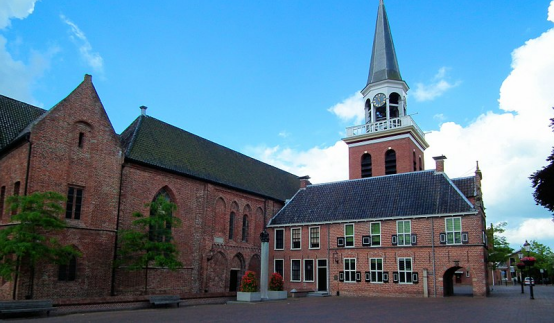
Nicholas Church (left) and renaissance town hall (right) in Appingedam
二、自然地理
Appingedam's railway station is Appingedam railway station.
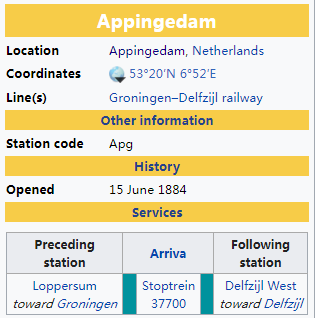
Appingedam is a railway station in the city of Appingedam, Netherlands. The station was opened on 15 June 1884 and is located on the Groningen–Delfzijl railway. Nowadays the station is unstaffed. Only basic platform facilities, as a shelter and a ticket machine, remain. The station is owned by ProRail and operated by Arriva.
Former building
The original station building was nominated for heritage status, but was demolished after a fire in 1978.
Services
Trains
The following train services operated by Arriva currently call at Appingedam:
2x per hour local service (stoptrein) Groningen – Delfzijl
Buses
At the station, there are two bus connections operated by Qbuzz with the following destinations:
45: Delfzijl – Appingedam – Holwierde – Beirum – Spijk – Losdorp – Godlinze – 't Zandt – Zeerijp – Loppersum (1x per hour)
91: Appingedam – Holwierde – Krewerd – Oosterwijtwerd – Leermens – Eenum – Loppersum (5x per day)
140: Delfzijl – Appingedam – Ten Boer – Groningen (1x per hour)
三、经济发展和规模
Total » Total » A-U All economic activities - Appingedam - Electricity. delivered
17,477.00 1,000 kWh in 2018
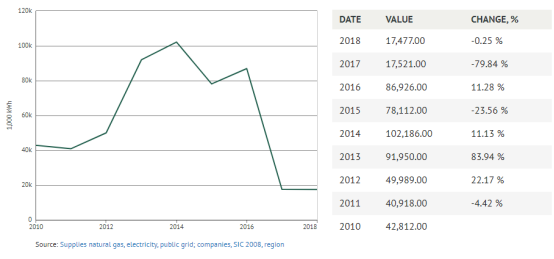
Total » Total » A-U All economic activities - Appingedam - Natural gas, delivered
2,994.00 1,000 m3 in 2018

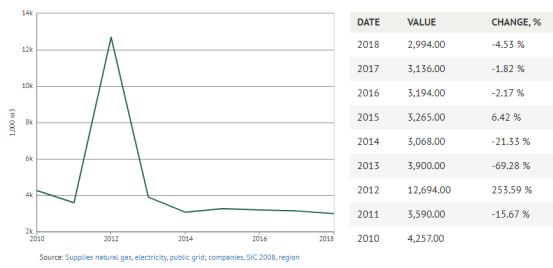


Appingedam - Average purchase price
194,795.00 Euro in 2019
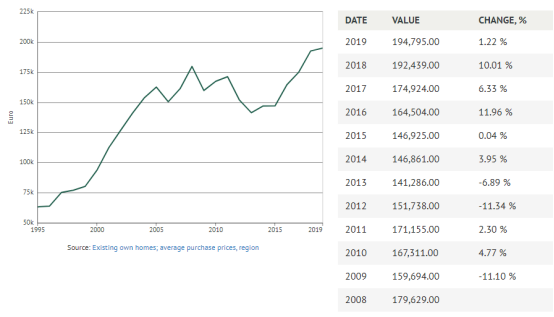
四、产业特点/重点项目
Doubling N33
Rijkswaterstaat and the province of Groningen are jointly working on doubling the national highway N33 between Zuidbroek and Appingedam.
Schedule
2018 Definitive preferred alternative
2019-2020 Draft route decision
The preferred alternative is further elaborated in a draft route decision / Environmental Impact Assessment (EIA). All effects are examined even more specifically and the design is further optimized. This leads to a large stack of research reports and drawings. This is expected to be completed in the spring of 2020. These are then placed for inspection for six weeks. This is announced in the Government Gazette and the regional newspaper and door-to-door newspapers. Interested parties can submit an opinion on this. The project group incorporates these reactions in the plans where possible. In the so-called Memorandum of Answer, the respondents receive a response to their opinion.
2020-2021 Route Decision
With the processing of the views of interested parties, the design has been further optimized into a Route Decision. The Route Decision will also be made available for inspection for six weeks, it is expected that this will take place in early 2021.
Interested parties who have responded to the draft route decision can appeal against this decision to the Administrative Jurisdiction Division of the Council of State. If there are no appeals or if the Council of State has rejected them, the Route Decision is irrevocable. This gives the green light for the realization.
Once the route decision is irrevocable, the province and municipalities involved must ensure that the chosen solution is implemented in the area. They do this by adjusting the zoning plan and, for example, granting the necessary permits.
2022 - 2025 Realization phase
The Route decision for the project has been taken. The realization of the road can be started. All procedures have been completed and financial resources are available. The work can begin.
The Unity
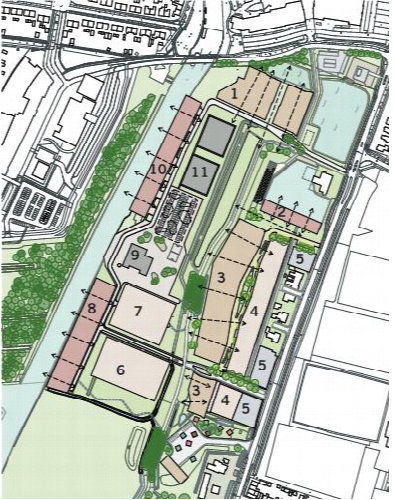
Over the next 10 years, the municipality of Appingedam will build a new, high-quality residential area on the site of the former cardboard factory De Eendracht. We want a mixed green design with space for living, working, care and recreation. An estimated 200 homes will be built until the year 2030. The development of the area is done in small steps. The municipality selects companies for each residential field for the development and realization of the houses. In 2020 we will start building the first 50 homes and tiny houses.
Would you like more information about the De Eendracht housing site? Then you can email project leader J. Reinsma: J.Reinsma@appingedam.nl .
The tip
Residential building location 'De Tip' is a peninsula on the west side of the city center, within walking distance of the city center of Appingedam and shopping center 'Overdiep'. It is located between the Damsterdiep, the Nieuwe Diep and the Bouwmeestersstraat. The municipality of Appingedam, Woonstichting Groninger Huis and project developer Heuvelman Projecten BV will develop the area together.
Below we will keep you informed about De Tip.
3D animation De Tip
https://youtu.be/Qu3dT6J4KX4
Architectural firm Adema Architecten from Dokkum has made a 3D animation of De Tip's urban plan. It gives an impression of what The Tip will look like
Reclassification
On 1 January 2021, the municipalities of Appingedam, Delfzijl and Loppersum will merge as one new municipality.
Reorganizing municipalities always takes a few years. The Arhi Law states what needs to be arranged and when. The States General (the Upper and Lower Houses) take the final decision. But before it can be treated in the Chambers, there are many more steps to take. In addition to regulating the legal part, municipal organizations and systems must also go together. There are elections for a new city council just before the new municipality starts. In order to go through all these steps properly, the three municipalities have been conducting research and planning for some time.
五、风景名胜,景点
Rich medieval architecture
In medieval times, Appingedam was the capital of the district of Friesland called Fivelingo from where trade was conducted with northern Germany and the Baltic area, Scandinavia and Westphalia. Appingedam was an important regional market centre and harbour. The riches which were accumulated in this period are reflected in the architecture and history of the town which is displayed in Museum Stad Appingedam.
Harbour
The harbour on the Overdiep is a lovely spot where leisure boaters can moor for a few days and explore Appingedam and the surroundings.
Explore Appingedam from the water
Damsterveer
Every Saturday afternoon, the Damsterveer ferry makes two trips around Appingedam. This provides a unique opportunity to see another side to historic Appingedam from the water.
You literally sail under the hanging kitchens, see the unique medieval facades and the many bridges. In just under an hour, you make your day in Appingedam complete!
Reference: https://eemsdelta.groningen.nl/en/about-the-region/historical-town-appingedam
Museums in Eemsdelta and Hoogeland
Northeast Groningen has a wide range of museums, from small ‘living room” museums to bigger ones with collections where you can spend hours browsing. The collections vary from cultural history to art and special and exclusive collections. Here is a list of all the museums, big and small.
The highlights in the region
Hoogeland open-air museum
The open-air museum gives you an idea of what it was like to live and work in the countryside in around 1900. Twenty recreated buildings, including a primary school, a village café, a Jewish butcher and a painter’s workplace take you back a century. In the old village café, you can still enjoy something to eat and drink. Children can walk on stilts, try out hula hoops and skipping ropes.
Museum and Menkemaborg garden
The Menkemaborg is a fully recreated castle with gardens, moats and a canal, which give an impression of living in a Groningen estate in the 18th century.
Particularly interesting exhibits are the baroque chimneypieces, the four-poster bed, the gentleman’s study and the kitchen. Besides the formal garden, there is also a special sundial garden and an orchard. The rose tunnel in the vegetable and herb garden flowers in July. Estate farmhouse with restaurant.
Museum Møhlman Appingedam
The Museum has three permanent collections:
the Canto Collection, the Møhlmann Collection I (works by modern realist and figurative painters) and the Møhlmann Collection II (works by the painter himself).
Every year, 2 temporary exhibitions are organised.
Museum Stad Appingedam
Museum Stad Appingedam is a cultural-historic museum which provides information about the history and development of the town of Appingedam and the Fivelingo area, focusing particularly on architecture, urban planning and development.
Muzeeaquarium Delfzijl
Visit a stalactite cave and a megalithic tomb ('hunebed'). Admire the variety of shapes and colours of shells. Revisit the maritime history of Delfzijl. This is all possible in the North Sea museum and aquarium Muzeeaquarium Delfzijl.
The museum has four unique collections:
Archaeology, Geology, Shells and Shipping.
六、历史文化
Medieval Appingedam
Appingedam evolved on the banks of the waterway of the Delf, today known as Damsterdiep, around 1200. The name of the town is a lexical compound meaning “the dam built in the Appe” or “Apt.” The junction of the Apt and the East-West canal proved convenient as a location for the foundation of a lively trade settlement. Established by shipmasters, tradesmen and craftsmen, Appingedam was first mentioned in a historical document dated 1224. Next to Groningen, Appingedam was thus the second of the two urban centres upon which the Frisian region of Fivelingo would build its fame in the Middle Ages.
Trade Centre
Owing to its favourable location at the junction of inland waterways and thus to its open access to the sea, the settlement soon developed into a vibrant centre for shipping and trade. With seagoing ships loading and unloading freight at its two busy quays located on the opposite banks of the canal, wealth would flow into the City. Stored in Appingedam and traded in its markets, the goods would subsequently be transported via inland waterways to the northern regions of Germany, Westfalia, and even further into the Baltic Sea area. The exchange of goods, continually contributing to the growing affluence of Appingedam, quickly rendered it the dominant city of Fivelingo.
The “Neighbour Letter”
An important seaport and a trade hub, mediaeval Appingedam would soon become a legally acknowledged administrative centre. In 1327, Appingedam's city rights were recognized by the Council associating representatives of seven Frisian sea states, who signed the treaty confirming Appingedam's independent status at Upstalboom, which today is the East Frisian city of Aurich. The rights and privileges granted to Appingedam were listed in a document which went down in history as the “Neighbour Letter.”
Further Developments
The City of Appingedam flourished over the next two centuries. The 14th century brought about the construction of a large church complex, a convent, a guesthouse and two fortified castles of Ripperda and Snelgersma. Work on the development of the system of canals and mooring docks continued well into the 15th century, and it is till this day that some of the 600-year-old structures may be admired along the winding waterfront avenue leading from Koningstraat to Westersingel.
Conflicts with the City of Groningen
The economic development of Appingedam would, however, increasingly threaten the vital interests of the City of Groningen. The growing tension between the two cities eventually escalates into a series of armed conflicts. In 1536, Appingedam suffered a major defeat, as a consequence of which the city was destroyed and ultimately lost its position as a major player in the region's trade and politics. Although since then Appingedam's economy would gradually deteriorate, a temporary revival could be observed in the 1630s, when the City Hall was built and later, around 1760, when the reconstruction of the facades of the gabled houses in the Solwerdstraat commenced However, it was not until the end of the 18th century that the development of the City would regain its momentum: the turn of the centuries brought the establishment of regular railway services between Appingedam and Sneek, Amsterdam, and a few German cities, but it was only in 1884 that the City received a new railway station, representing an architectural style known as the Sneek-Standard-Style.
Traditional Industries
Along the Damsterdiep, a number of businesses—foundries, brickworks, limestone quarries, sawmills, and other industries supporting the dockyard operations or related to the region's agricultural production—emerged over the years. Catering to the needs of the local bakeries and of trading companies, the nearby windmills would produce flour and the local oil presses would supply oil, but apart from these industries, the City of Appingedam also boasted six beer breweries, two gin distilleries, several tanneries, spinning factories and many other production companies.
"Brons" Engine Factory
The economic boom of the late 19th century, propelled by the increase of the value of the cattle markets and, in particular, development of the horse market, allowed Appingedam to thrive again. Even though the importance of the waterways decreased after the Groningen-Delfzijl railway line opened, at the beginning of the 20th century thus diminishing Appingedam's profits on water transportation, the former trade hub reinvented itself as a major industrial centre in the region of Fivelingo. In 1870, C. Roggenkamp implemented the first steam-engine in Appingedam and founded the first steam-propelled sawmill timber in the Netherlands. Soon thereafter, other steam-run machines were implemented in Appingedam factories, further increasing the wealth of the city: a threshing machine and a crank press. At the beginning of the 20th century, the City already boasted a dairy factory, a flax factory, a cardboard manufacture, gasworks, a trailer factory, as well as the plants of busbuilders Medema and Smit. The "Bronsmotorenfabriek" (Brons Engine Factory), Ter Borg & Mensinga, an Appingedam-based mechanical plant named after its founder Jan Brons, gained international fame when its foundry produced the first Brons engine, catering for the needs of modern shipping, enjoying worldwide sales. The huge crankshaft of the first “Source” model may be admired today at the corner of the Kniestraat and Dijkstraat, as an industrial monument. Another mechanical plant with worldwide sales was Ter Borg & Mensinga.
Post-War Appingedam: A Battered Town
At the end of World War II, unlike the remaining regions of the Netherlands, the Eemsmondsregio, Appingedam and Delfzijl suffered major damage as a result of heavy shellings by the Nazi artillery. Many of the Appingedammers (or Damsters) were evacuated and the city itself, guarded by a handful of defenders, would suffer a ten-day-long agony until May 2, 1945, when it was eventually liberated by the Canadian troops. The returning inhabitants found their hometown heavily battered and even though its reconstruction commenced immediately, it took decades to restore Appingedam to its present glory.
“The Face of the Town”: Appingedam Under Protection
Immediately after World War II, Appingedam's star became largely eclipsed by the neighbouring city of Delfzijl, which developed rapidly and gained the status of the third port of the Netherlands and one of the most important industrial centres in the north of the country. In Appingedam, the transformations took much more time and in some areas of its economy, such as shopping, a standstill could be observed. The much needed incentive to speed up the change came in 1972, when the Appingedam acquired the status of a conservation area. This opened new legal and financial opportunities before the City Council, which thus gained the means to jump-start restoration, breathing new life into the rundown inner city. Ambitious plans to restore the historic centre of Appingedam in keeping with its unique, centuries-old identity were soon devised and implemented at an enviable pace.
Damsterdiep
The restoration of the downtown Damster proved to carry major consequences. Not only was the physical appearance of the city reverted to the state of its former glory, but also the life of Appingedam gained momentum. Under the motto of “Appingedam—Back in Service,” the council made a successful attempt to draw tourists and entrepreneurs back to city. The development of Appingedam involved the activation of the recreational sector, the effects of which would become particularly visible after the opening of the Damsterdiep sailing circuit. The city would quickly expand; modern homes in large housing estates or cosy suburban areas would quickly spring up and a variety of shops and attractive recreational facilities, good roads and efficient public transportation would become landmarks of the present day Appingedam. Today, Appingedam is a major tourist centre for the North-East of the province of Groningen. It has also developed into regional “care centre,” both in terms of governance, and in the field of education and shopping facilities.
Overdiep
Overdiep is the most recent project in the field of town renewal in Appingedam. It is a large-scale living, shopping and recreation complex, which is characterised by sympathetic architecture that blends with the character of the old centre of Appingedam. The venue takes its name from the new Diep, which forms the border between the old centre of the city and the surrounding area. Overdiep borders directly to the historical centre of Appingedam, with splendid visibility on the Nicolaïkerk and surroundings. In 2009, the first houses were constructed along with a health centre, as well as a new yacht-basin and pavilion. The last phase of the complex was realised in 2011.
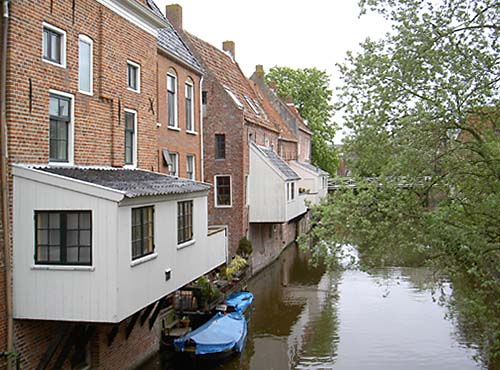
The hanging kitchens over the Damsterdiep
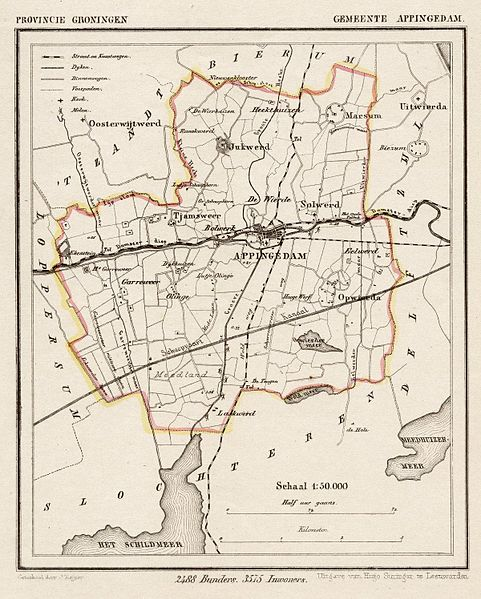
The municipality of Appingedam around 1866 (Atlas of the province of Groningen 1865-1870)
七、其他信息
City of Appingedam, since 1327.
A complete city with a medieval center, where we cherish and protect our cultural history and the water. The historic city center, with the central Nicolaïkerk and the Raadhuis, offers a splendid backdrop for cozy shopping with a wide range of shops and for browsing or settling down on the attractive terraces at the catering establishments. A nice addition is the modern Winkelhart Overdiep, which is within walking distance.
You can still experience history in Appingedam today. The abundance of water and the harbour bring atmosphere to the town, whose old historic centre leaves an indelible impression. Appingedam is ideal for exploring by boat. Paddle a canoe under the famous hanging kitchens and stop at the new Marina. This harbour is in the centre of the town, in the middle of the Overdiep.
Hanging kitchens of Appingedam
The main attractions of Appingedam include the impressive Nicolai church and the Raadhuis, the Renaissance style town hall built in 1630, the historic Solwerderstraat and of course Damsterdiep with its lovely bridges and hanging kitchens. Leisure boating is also becoming popular following the opening of the Damsterdiep boating circuit.
八、联系方式

Mayor: Koos Wiersma
Born: June 14, 1955 (age 65 years)
Twitter: Koos Wiersma @FokkoW
Contact details
Address: City Office Appingedam
Wilhelminaweg 14, 9901 CM Appingedam
Post: PO Box 15, 9900 AA
Tel: 14 0596
Fax: (0596) 691 101
Email: info@appingedam.nl
From abroad +31 596 691100
Twitter: Appingedam @GmAppingedam
Facebook: Gemeente Appingedam @gemeenteappingedam
